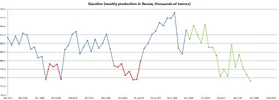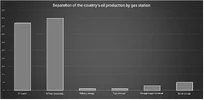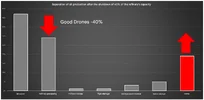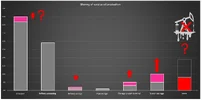March 29, 2024, 12:01 AM
Fear has high prices
The Russian fuel market fears a shortage.
The government, amid the shutdown of several refineries, is trying to prevent a fuel shortage in Russia. The first step was a ban on gasoline exports. The second step could be to prioritize the transportation of petroleum products by rail and provide companies with tank cars. Experts believe that this could, in theory, help stabilize the market, but much will depend on the final timing of scheduled and unscheduled maintenance at the refineries.
Expand to full screen
Photo: Viktor Korotaev, Kommersant
The main goal of the state and the Russian fuel and energy sector over the past two months has been ensuring sufficient fuel supplies for the domestic market. And so far, this has been achieved. According to the Ministry of Energy, gasoline shipments to Russian consumers in March increased by 13,000 tons per day compared to February (to 794,000 tons), while diesel fuel shipments increased by 15,500 tons per day. Moreover, according to the Central Dispatch Office of the Fuel and Energy Complex, as of mid-March, supply volumes exceeded production volumes for the first time since September 2023. Production for the week of March 13-19 fell by 3.9% compared to the previous week and by 5.2% compared to the planned level, to 779,400 tons (111,300 tons per day). Oil companies were able to cover the difference by drawing on accumulated petroleum product inventories, which as of March 22 amounted to 1.9 million tons of gasoline and 3.4 million tons of diesel fuel.
A blow to primary processing
The risk of fuel shortages arose due to refining capacity shutdowns at several refineries. The first to fail, early in the year, was the catalytic cracking unit at one of Russia's largest refineries, LUKOIL's Nizhny Novgorod Refinery (with a monthly capacity of 200,000 tons). The failure was caused by a breakdown of imported compressor equipment, which cannot currently be replaced due to Western sanctions. According to authorities, finding an alternative and repairing it will take from several months to a year and a half. Over the next two months, drone-related accidents occurred at LUKOIL's Volgograd Refinery, Rosneft's Tuapse Refinery, and the Ilsky Refinery in the Krasnodar Territory. However, the damage to their facilities had little impact on domestic supply, as the refineries were primarily export-oriented.
Russian oil companies suffered more significant losses in March. On March 12, drones damaged a primary oil refining unit at LUKOIL's Nizhny Novgorod refinery, which accounts for 53% of the refinery's capacity. Its failure could lead to a nearly halving of diesel fuel output and a quarter-decrease in gasoline output. Drone attacks on March 13 and 16 disabled two similar units at the Ryazan refinery (with a capacity of approximately 35,000 tons per day) and one at the Syzran refinery (17,000 tons). Both plants are owned by Rosneft. Reuters calculated that the decline in motor gasoline production at Ryazan Oil Refinery could reach approximately 35%, despite a 70% reduction in refinery utilization, if the catalytic cracking unit is provided with the required feedstock. The decline in motor gasoline and diesel fuel output at the three sites could total up to 5.8% and 6.6% of Russia's total, respectively. However, market participants believe this reduction will not be critical and can be offset by other Russian refineries, which have sufficient capacity to produce additional fuel during the low season. Reuters estimates the total capacity of primary oil refining units downtime following the attacks at 13% of Russia's total capacity.
Granaries of the Motherland
Despite unscheduled maintenance at these refineries, the Ministry of Energy forecasts primary oil refining volumes in 2024 to remain at last year's level. By the end of 2023, oil refining in Russia increased by 1.2%, to 275 million tons. "The forecast for oil refining volume remains at a level close to last year," said Minister Nikolai Shulginov on March 20. At the end of February, he reported that oil refining had decreased by approximately 7% since the beginning of 2024. However, First Deputy Minister Pavel Sorokin later stated that primary refining by the end of this year will be lower than last year, but that these volumes will allow Russia to increase exports.
Sergei Kondratiev of the Institute of Energy and Finance predicts that production by the end of March will likely be 4% below plan, which, given existing reserves, will help avoid a shortage on the domestic market. In April, he believes, the fuel market situation will depend on how quickly damaged units can be restored to service and how quickly other refineries can be loaded.
Provide at any cost
To prevent fuel shortages on the domestic market, the government took a number of measures. The first step was a ban on the export of all types of gasoline, effective March 1, until August 31. Exceptions apply to supplies under international intergovernmental agreements, including with member states of the Eurasian Economic Union, as well as to fuel exported by citizens for personal use and for international humanitarian aid. Also, effective March 1, the standard for diesel fuel sales on exchanges was increased from 12.5% to 16%.
However, the introduction of an embargo on gasoline exports disrupted traditional logistics models, complicating the situation with rail shipments. First and foremost, confusion arose regarding shipment destinations and priorities. This is because certain cargoes are being exported from Russia on a priority basis. These include military supplies, emergency response supplies, and cargo ordered by the president, including coal from Kuzbass, Khakassia, Tuva, the Irkutsk region, Buryatia, and Yakutia.
Now, petroleum products may also be added to this list. According to Kommersant, fuel will receive higher priority on rail transport than other cargo. Following a meeting on the domestic petroleum product market on March 22, Deputy Prime Minister Alexander Novak instructed oil companies, in conjunction with Russian Railways, to "ensure the uninterrupted export of petroleum products and the loading of refineries in accordance with the schedule and growing spring demand." As part of these instructions, the Ministry of Energy, oil companies, and Russian Railways are developing monthly petroleum product transportation schedules, the implementation of which will be monitored by the government.
The transport monopoly itself stated that the railways have already adapted to the new situation. "The change in established supply chains required a significant restructuring of the technological process. We are cooperating around the clock with oil companies and tank car owners. We have redistributed resources to ensure the timely processing of trains at loading and unloading stations," Russian Railways noted. According to the company, the loading of petroleum products for the domestic market increased by 11% during the week of March 18–24 compared to the same period last year. Domestic shipments of gasoline and diesel fuel have increased by 9.5% since the beginning of March, including a 22.3% increase to the east.
The cabinet also oversaw the timely unloading of railcars carrying petroleum products. Market participants regularly complain that petroleum products purchased at refineries can take over two months to reach consumers. Kommersant's sources point out that the monopoly has historically failed to plan domestic bulk oil shipments and fails to comply with conventions regarding shipments to problem areas, leading to overstocking of tanks and railcars. The Ministry of Energy expects petroleum product export volumes to increase due to increased railcar turnover through improved planning (including for exchange-traded cargo), as well as coordination between oil companies and Russian Railways. However, improved fuel export efficiency should not worsen the situation with the export of other cargoes.
According to Mikhail Burmistrov, head of Infoline-Analytics, prioritizing fuel on the railway will reduce the risk of fuel shortages during the start of the sowing season and could also positively impact dispatching on the network by reducing tank car downtime.
Meanwhile, oil producers are noticing not only the slow railway but also a shortage of tank cars. The heads of major oil and gas companies—LUKOIL, Gazprom Neft, Tatneft, and NOVATEK—have appealed to Deputy Prime Minister Alexander Novak to address the worsening problem, Interfax reported. Approximately 180,000 tank cars are used annually to transport approximately 220 million tons of oil cargo. However, since 2022, the country has experienced a shortage due to the high rate of decommissioning of tank cars at the end of their service life. Overall, approximately 65,000 tank cars have been decommissioned over the past ten years, while only about 16,000 new ones have been purchased, according to the companies. Furthermore, sanctions have increased the turnaround time for tank cars on the Russian Railways network. The monopoly, for its part, is confident that its existing fleet of tank cars is more than sufficient to handle both domestic and export shipments. They point out that in February, nearly 18,000 oil and gasoline tank cars sat idle on private tracks every day, with oil producers often using the cars as "wheeled warehouses."
Quotes were scared by the damper
Market participants' nervousness about a potential shortage pushed wholesale fuel prices on the St. Petersburg International Mercantile Exchange (SPIMEX) upward throughout the second ten-day period of March. Prices for AI-92 gasoline began rising on March 11th from 46,900 rubles per ton, and by March 22nd, after a steady rise, they reached 54,100 rubles per tonne (a 15.3% increase). The price of AI-95 gasoline rose 14% over the same period, reaching 66,900 rubles per tonne. Market participants attribute this sharp increase, in part, to the fact that large oil companies are entering the exchange as buyers, needing to supply their own filling stations with petroleum products. The situation is also complicated by the suspension of sales at motor depots. However, since March 23rd, the prices of the two most popular gasoline grades have begun to decline.
Diesel fuel prices also adjusted, as prices reached the threshold for receiving the export subsidy for March. Oil companies lose this subsidy if the average monthly price of AI-92 gasoline or diesel fuel on base stocks in the European part of Russia exceeds the notional domestic market price set by the government by 10% and 20%, respectively. For 2024, this figure is 66,600 rubles per ton. "Oil companies are already faced with the task of containing prices in March, as diesel fuel is trading close to the cutoff point for damper payments," says Maxim Dyachenko, Managing Partner of Petroleum Trading. He notes that the fuel market calmed somewhat towards the end of March amid increased sales by vertically integrated oil companies, but prices remain relatively high amid the upcoming spring repairs. In his opinion, in the long term, prioritizing fuel deliveries by rail could, in theory, improve the situation, but the details of this measure are not yet clear.
Irina Salova













